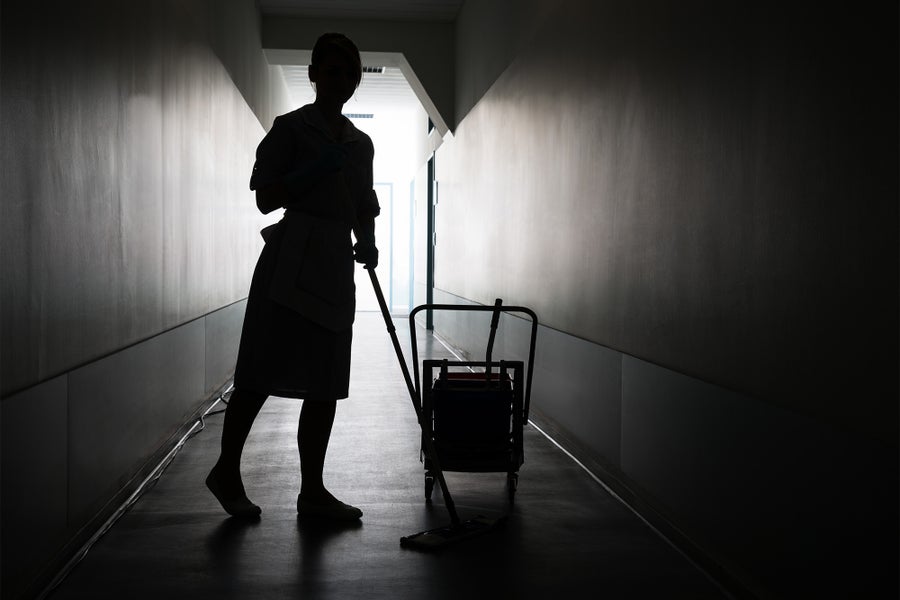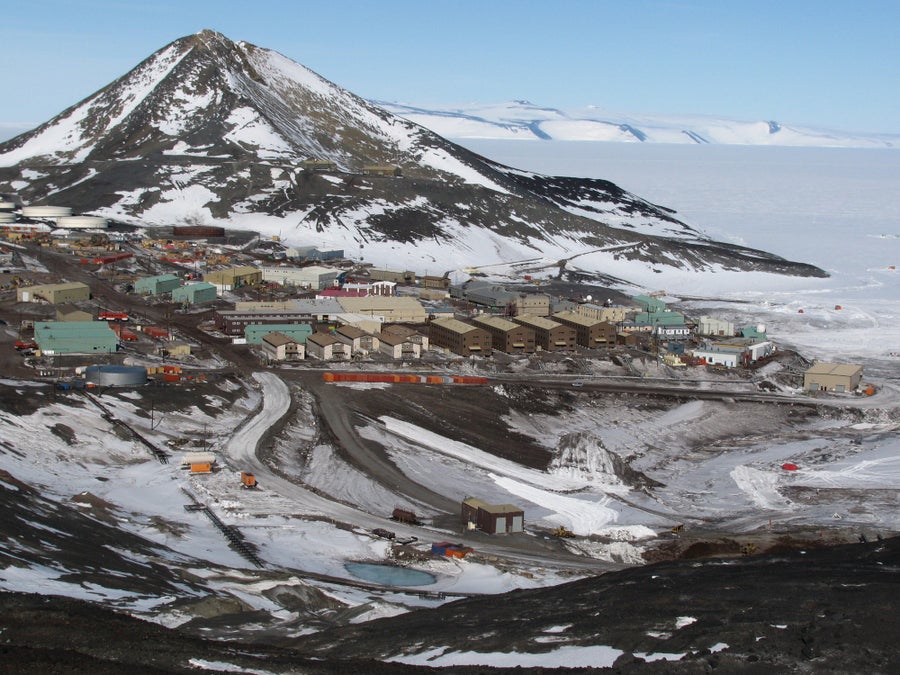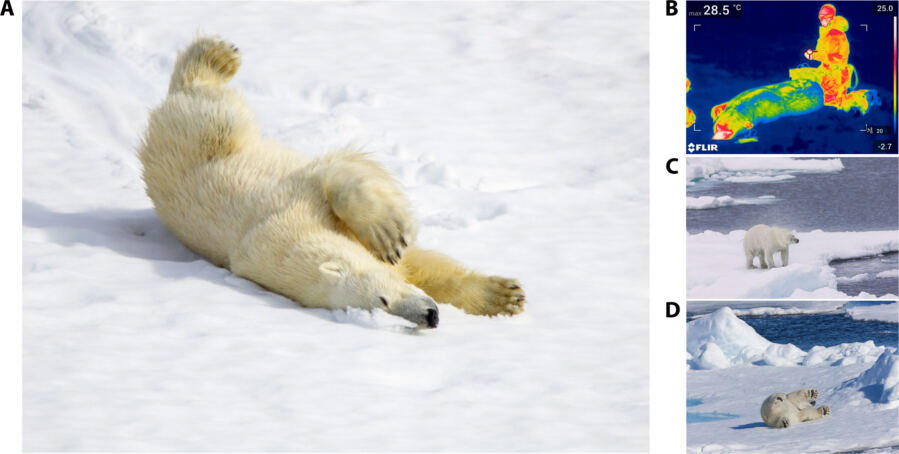For two years, I worked as a janitor at McMurdo station in Antarctica, mopping the floors of scientists on the cutting edge of wildlife, weather and climate research. Tasked with scrubbing toilets and degreasing showers, I wore the same pair of sea green latex gloves for many hours, six days a week. During my first deployment in 2010, these gloves quickly became an extension of myself; I barely noticed them. This abruptly changed about a month later.
That morning started like any other—I had an assigned building in which I vacuumed hallways and removed trash bags of carefully sorted waste. While preparing to clean the bathrooms, I breezed into the supply closet where I kept a bucket of supplies: scouring powder, disinfectant spray, clean rags and my trusty gloves. But I recoiled when something inside the gloves caught my eye. Looking closer, I discovered a used condom. I slid it out, disgusted. Written on it in permanent marker were the words for jano girl. I was embarrassed, violated and frightened, but not surprised. I’d been warned something like this might happen.

Thirteen years later, the Antarctic summer is now in full swing. Several thousand people are swelling the continent’s population in their pursuit of science, descending on a handful of stations, most of which are run by the National Science Foundation. Around 1,000 people have settled at McMurdo, the logistical hub and heart of the Antarctic science mission. Sexual harassment and assault have been part of too many Antarctic experiences. NSF must do more to fix these decades of violation and neglect.
Much of the attention to this problem at the emptiest, windiest, highest, driest, coldest place on Earth has focused on scientists harassing other scientists. Yet, depending on the season, support staff—the janitors, cooks, trash sorters and other people who keep the stations functioning—outnumber researchers in Antarctica roughly seven to one. These jobs, administered by National Science Foundation contractors, keep the stations warm, the scientists fed and buildings clean. Yet my own experience with the whisper network among the women who work at these stations, and now, the multiple whistleblower stories, show clearly that the people who maintain Antarctic science endeavors do not have a safe working environment.
In 2022, the NSF published a report highlighting the ways in which the agency has failed its Antarctic employees. It said that 72 percent of current and former female employees believe sexual harassment and assault in Antarctica is a problem, that 59 percent of women had experienced it themselves, and 95 percent knew someone directly affected. Women I worked with during my three years have come forward to tell their stories in the wake of the report. Finally, it seems the plight of Antarctic workers is getting attention.
The people who make research possible have often been treated as dispensable, resulting in a hierarchal culture rife with victim blaming. And while NSF has vowed to make these stations safer, the effort is too late for so many, including me.
Earlier this year, as I was working on this essay, my editor suggested I file a Freedom of Information Act request with the NSF for my personnel file. I asked for any documentation the agency had on what I experienced and reported. I wanted to better understand what my supervisors had done to try and find the perpetrator, or to stop the harassment. The condom was one of many violations I experienced while working at McMurdo, and they still affect to me to this day.
Soon after the condom, I began finding notes scribbled on paper towels, scrawled with slurs and threats and stuffed in the pockets of my patched puffy coat, which I was required to hang in an open area with dozens of other jackets. Sometimes, I’d find notes tucked into my bucket of cleaning supplies, calling me degrading names and informing me that I was being watched. I was 23 years old, a recent college graduate and the third generation of my family to traverse the thousands of miles from the U.S. to McMurdo. And now, I found myself having to tell my older, male supervisor all the ways that someone was stalking me.

Antarctica’s harassment problem is, in part, a consequence of gender disparity: of the 3,000 or so scientists, contractors and military personnel NSF sends to its various stations and field camps on the continent, two thirds are male. To understand how many people it takes to keep the stations running: in addition to “janos,” there are “wasties” who sort and package trash so it can be shipped back to the U.S., and “fuelies” who supply the planes transporting people, food and equipment between continents. Dining attendants fill silver troughs with the sustenance chefs have alchemized out of forlorn frozen food. Shuttle drivers ferry scientists along icy roads maintained by the roaring tractors of the Fleet Ops crew. Everyone contributes to the Sisyphean task of shoveling out doorways buried overnight by constant caterwauling gusts that bury everything in snow. Support staff does not just support science; they enable it.
When I first arrived, female co-workers whispered warnings to me during job trainings: Avoid being alone in the more isolated buildings and be sure to know where the exits are. Circumvent “Man Camp,” the transient bunk room of men destined for remote field camps. Stay away from the “Gang Bang shower,” named for reasons I dare not think about.
While this advice illustrated how pervasive the harassment was, none of it kept me from being victimized, and none of it assisted me in getting the help I needed.
Each report led to in-person meetings with HR and the NSF representative at the station; back then, we didn’t have regular access to e-mail, so hardly anything I told them was in writing. These meetings were embarrassing and demoralizing, and the people in these meetings treated me like an inconvenience. They called my being threatened and sexualized, “your situation.” My male co-workers told me they’d been warned not to be alone with me in order to avoid becoming suspects. Rather than tell me how they would prioritize finding the person who was doing this to me, both the NSF representative and the contractor who hired me made me the problem.
When I initially filed my FOIA request this year, I was met with a quick reply: NSF was “unable to locate any responsive records,” as they’d been destroyed. This was again demoralizing, because while I wasn’t looking forward to reliving these experiences, I had hoped the files would give me clarity on something that’d left me confused and upset, even after so long. Then, a few weeks later, NSF wrote to me again. The agency retracted its original response, and said it would do the research again. Nearly three months later, they sent a slew of documents outlining most of the incidents I had reported, as well as other reports and e-mails discussing what my supervisors and higher-ups had done in response.
One document in particular detailed some of the ways in which leadership scrambled toward justice. They talked about interviewing suspects, mused about acquiring security cameras, inquired about DNA testing, and hatched plans of stakeouts. But they never mentioned these things to me in any real detail. I worked in Antarctica for three years, two as a janitor, and felt ignored, isolated and unsafe more or less the whole time.
The 2022 report explicitly discusses how support staffers do not trust their hiring contractor’s human resources department to support them—which means that by proxy, hundreds of people who work at McMurdo, Amundsen-Scott South Pole Station and Palmer Station do not trust the NSF. This means the agency has to hold its staffing contractors accountable. It needs to fully account for the decades of wrongdoing at its Antarctic research stations and explain why it’s taken so long to act.
After a month in which I repeatedly reported the harassment to HR, the agency encouraged me to transfer to a different station. This fact is glaringly absent in the FOIA documents. I said no—I didn’t want to leave McMurdo. I’d met the man who would eventually become my husband, I’d made lifelong friends, and working on the southernmost continent was my family’s legacy, something very few people can say. Plus, this was a decent-paying job for a young person in the midst of an economic downturn, the practical reason why so many of us decided to leave our comfortable, more temperate lives to come so far south.
Instead they then offered me a payout to go home. NSF and its contractor tried to solve the problem by asking me to disappear. Meanwhile, the 2022 report describes female staff being so worried that they would avoid certain buildings, or carry a hammer for protection. They also said they knew better than to report, because when support staff report abuse, they were often sent home or blacklisted. The report only covered three years of deployments, and so much of it mirrored my own experiences. It’s incredible to me how this went on for so long without any real action, and my personnel file speaks to this; management was fumbling for solutions to a problem that has existed for decades.
In 2010, there should have been plenty of security cameras in place—but there weren’t. The contractor and NSF could have had safety protocols to prevent harassment. But making women and victims the problem has long been standard in Antarctic science. By 2011, women had been on the continent for over four decades; they’d not been allowed until November 1969. The first females had to stay in a tent 200 miles from station so they didn’t “cause trouble.” Never mind telling the men to simply leave them alone.
NSF has stringent protocols in place to keep personnel safe from risks like frostbite or wandering off in a blizzard. It has strict regulations to ensure wildlife can live undisturbed. But it’s only recently that the agency has started to tackle sexual harassment and assault within its Antarctic workforce. In response to the report, it issued a statement detailing the preventive actions it plans to take such as bystander intervention training, increased security in the form of peepholes installed on doors, and more rigorous screening of job candidates. It’s set up a new confidential crisis hotline, and just recently sent down third party investigators. These are excellent steps forward, but it’s not enough if NSF won’t hold its contractors accountable for creating what amounts to a hostile work environment in one of the most hostile environments on the planet.
After NSF’s report was published, Leidos (which currently holds the Antarctic Support Contract) testified to Congress about sexual harassment and assault. Its officials initially couldn’t quantify the problem from the time the company had taken over the contract in 2016. They then backpedaled after facing backlash and provided data indicating only some cases of harassment, despite a well-known assault in 2019. When I was being routinely harassed, Raytheon, the contractor at the time, shifted me into different workplaces, different routines, and shuffled me out of view. In one of the FOIA documents I received, an HR representative wrote: “The investigation seems to be at a standstill.” It’s easy to suggest there isn’t a problem when you choose to ignore it.
NSF has been quick to blame alcohol and has changed the way it’s sold this season, turning the two popular bars into BYOB recreation rooms. Alcohol certainly contributes to a highly charged environment, but a culture of hierarchy and rampant toxic masculinity are more meaningful contributors. I can’t be sure if alcohol fueled the person who did those things to me, but the fact that I was a female janitor who often worked alone was certainly motivation enough.

After my third year in Antarctica, I stopped going, choosing instead to settle in Denver and start my family. I now have a daughter, but I’m wary of encouraging her toward our family legacy of service in Antarctica. She would be the fourth generation of our family to work on the southernmost continent, but as long as women have been visiting, they haven’t been safe. By the time she’s old enough to go, this issue should be long settled, but will it be? I’m unconvinced.
NSF’s opportunity is now—it must put in place all the recommendations it made after that damning report and hold its contractors responsible for the welfare of the employees who work under its banner. It must punish perpetrators, not victims. Because without scientific support staff, there would be no science.
Earlier this fall, I attended a gathering of over 300 past and present Antarctic employees. It had the feeling of a big, wild family reunion, and I felt fortunate to be a part of the fold, so many years since my last season. But I still experienced the uneasiness I felt while being stalked, and during every concurrent season I worked in Antarctica: my stalker could be here, at this party. He was never caught.
A sentiment I heard from fellow female Antarcticans again and again that night was one of mistrust. Everyone agreed that it was meaningful to see NSF making some changes but we are holding our breath to see if it sticks in the absence of bad press. This loss of trust is the most important element that NSF has to deal with for Antarctic research programs to survive. Employees have been sounding the alarm bells for decades, knowing their greatest threat isn’t the ferocious frozen climate, but rather the predators around them and the government agency that hasn’t protected them. In the end, the NSF will not solve its Antarctic sexual harassment and assault problem until it values the people who keep the research stations running as much as it values the science those people make possible.
This is an opinion and analysis article, and the views expressed by the author or authors are not necessarily those of Scientific American.

























































